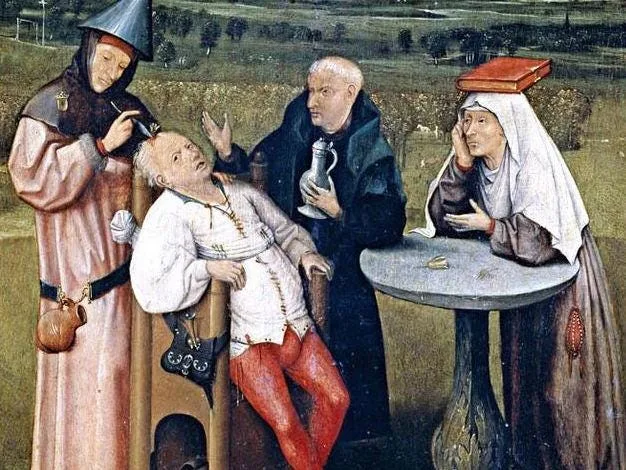7 Bizarre Medical Practices from History (That Somehow Worked)

Medicine has advanced significantly over the centuries, but the path to modern medical knowledge has been paved with strange, and often shocking, practices. In the absence of advanced scientific tools and knowledge, early doctors and healers employed a variety of methods that would make us cringe today. Yet, surprisingly, some of these Bizarre Medical Practices actually produced results — whether by luck, design, or a basic understanding of human physiology that wasn’t fully understood at the time.
In this extensive blog post, we will explore ten of these bizarre medical practices, explain how they were believed to work, and examine the science (or superstition) behind their occasional success. Some of these treatments even paved the way for modern medical techniques, proving that even the most outlandish ideas can lead to breakthroughs.
Introduction to Bizarre Medical Practices
When we think of medicine today, we imagine sanitized hospitals, advanced surgeries, and medicines designed based on years of research. However, throughout history, medicine was often a blend of trial and error, mythology, and rudimentary science. Early practitioners didn’t have the tools to understand infections, bacteria, or the inner workings of the human body, leading to some truly bizarre medical practices.
These methods might seem horrifying by modern standards, but many were considered state-of-the-art at the time. From bloodletting to cannibalism, early healers were willing to try anything in the hopes of curing their patients. What’s fascinating is that some of these practices actually worked — at least in certain cases. In this post, we’ll explore ten strange yet sometimes surprisingly effective medical practices from history.
1. Bloodletting: Draining for Health
Bloodletting is perhaps the most famous of all Bizarre Medical Practices. For thousands of years, it was one of the primary treatments for a wide range of ailments. The belief was that most diseases were caused by an imbalance in the body’s four humors: blood, phlegm, black bile, and yellow bile. By removing blood, physicians hoped to restore balance and, in turn, cure the patient.
The Practice
Bloodletting was done by either cutting a vein with a sharp object or by using leeches to suck blood from the body. The amount of blood removed varied depending on the illness being treated and the severity of the symptoms.
Why It Worked
While the idea of humors is now outdated, there were a few conditions where bloodletting was somewhat effective. For example, in cases of hypertension (high blood pressure) or polycythemia (a condition where the body produces too many red blood cells), reducing blood volume could provide temporary relief. Additionally, bloodletting helped doctors reduce inflammation and slow down the immune response, which might have been beneficial in certain inflammatory diseases.
Modern Adaptation
Today, bloodletting still exists in a more controlled form, known as therapeutic phlebotomy. This procedure is used to treat conditions like hemochromatosis, where excess iron builds up in the blood, and polycythemia.
2. Trepanation: A Hole in the Head
Trepanation, or drilling a hole into the skull, is one of the oldest known surgical procedures. Evidence of trepanation dates back to prehistoric times, and it has been found in many cultures across the globe. The reasoning behind it varied, from releasing evil spirits to relieving pressure on the brain.
The Practice
A small hole was drilled into the skull using rudimentary tools. Surprisingly, many of the patients survived, as evidenced by the bone growth around the holes in ancient skulls. In some cultures, it was believed that mental illnesses, epilepsy, or headaches could be cured by creating an opening in the skull to release the pressure or evil spirits trapped inside.
Why It Worked
Although the practice seems barbaric, there are situations where trepanation could have provided genuine medical benefits. In cases of traumatic brain injury, creating a hole in the skull could relieve intracranial pressure caused by swelling. By reducing this pressure, trepanation may have saved lives by preventing further brain damage.
Modern Adaptation
In modern medicine, a craniotomy (removal of part of the skull) is sometimes performed to relieve pressure on the brain in emergencies such as traumatic brain injuries or severe strokes. The tools are more advanced, and the procedure is much safer than its ancient counterpart.
3. Maggot Therapy: Nature’s Cleaners
Few treatments sound as unpleasant as letting maggots crawl over your wounds, but maggot therapy has been used for centuries to treat infected injuries. In the absence of antibiotics, doctors turned to these creepy crawlers to clean out dead tissue and promote healing.
The Practice
Maggot therapy involves placing live, sterile maggots on an open wound. The maggots consume dead and decaying tissue while leaving healthy tissue untouched. This process helps prevent infection and promotes faster healing.
Why It Worked
Maggots are remarkably efficient at cleaning wounds. They consume only the dead tissue, helping prevent the spread of infection, particularly in cases where gangrene or other severe infections have set in. Moreover, the secretions of maggots contain antimicrobial properties, which help to reduce the levels of harmful bacteria in the wound.
Modern Adaptation
Maggot therapy is still used today, particularly for chronic wounds such as diabetic ulcers or bedsores that do not respond to conventional treatments. The maggots used in modern medicine are sterile and are applied under controlled conditions.
4. Cannibal Medicine: Consuming Human Parts for Healing
One of the most macabre Bizarre Medical Practices is cannibal medicine, which was practiced in Europe from the Renaissance to the 18th century. During this time, it was believed that consuming human remains, particularly the blood, flesh, or bones, could cure a variety of ailments.
The Practice
Mummified human remains were often ground into powder and mixed into medicines. Blood was sometimes consumed fresh, while other body parts were used to create potions or salves. The idea was that the vital energy of the deceased could be transferred to the living and used to cure illnesses.
Why It Worked
While there’s no scientific basis for consuming human flesh or bones, some elements of cannibal medicine may have had unintended benefits. For example, bones are rich in calcium, and blood contains iron and other nutrients. However, any real therapeutic effects were likely minimal, and the practice was largely driven by superstition and a lack of understanding of diseases.
Modern Adaptation
Cannibal medicine, thankfully, has no place in modern healthcare. However, the fascination with using the body’s own tissues for healing persists in practices like blood transfusions, stem cell therapies, and organ transplants.
5. Mercury and Arsenic: Poison as Medicine
Throughout history, toxic substances like mercury and arsenic were used as treatments for a range of illnesses. Mercury, for example, was once used to treat syphilis, while arsenic was employed in various medicines for fevers and infections.
The Practice
Mercury was used in the form of ointments, pills, or even injections. Patients with syphilis, in particular, were often treated with mercury, sometimes leading to poisoning before the disease could be cured. Arsenic was similarly used in medicines, despite its known toxicity.
Why It Worked
While mercury and arsenic are highly toxic, they do have certain medicinal properties when used in controlled amounts. Mercury, for example, can kill bacteria and was one of the only available treatments for syphilis before antibiotics were developed. Arsenic, in small doses, was used to treat certain infections and fevers, and is still used in modern chemotherapy treatments for some cancers.
Modern Adaptation
Today, we understand the dangers of mercury and arsenic, but arsenic trioxide is still used in chemotherapy for certain types of leukemia. Mercury has largely been phased out of medicine due to its toxicity.
6. Fasting and Starvation: Purging for Purity
Fasting, or the deliberate abstinence from food, has been used as a treatment for various ailments for centuries. Ancient Greek and Roman physicians recommended fasting as a way to cleanse the body of impurities and restore balance to the humors.
The Practice
Patients would be put on strict diets, often consuming only water or small amounts of food for extended periods. The idea was that fasting would starve the illness and allow the body to heal itself naturally. Fasting was also used as a religious or spiritual practice, believed to purify both the body and soul.
Why It Worked
Fasting can have some health benefits, particularly in cases where the digestive system needs a break, such as after food poisoning or gastrointestinal illness. Modern science has shown that intermittent fasting can improve metabolic health and reduce inflammation. However, prolonged starvation is dangerous and can lead to malnutrition and organ failure.
Modern Adaptation
Intermittent fasting has gained popularity in recent years as a weight loss and health strategy. While it’s far removed from the extreme fasting practices of ancient times, it shows that controlled fasting can have benefits when done properly.
7. Corpse Medicine: Healing with the Dead
Throughout history, the dead have been used in strange ways to cure the living. From powdered mummies to the use of corpses in early medical experiments, this bizarre practice was once considered a legitimate form of medicine.
The Practice
In medieval Europe, doctors would often use ground-up mummy parts as a treatment for ailments such as headaches and seizures. It was believed that consuming the remains of the dead could transfer their life force to the living. This practice was not limited to mummies; in some cases, fresh corpses were used in potions or ointments.
Why It Worked
There is little scientific evidence to support the efficacy of consuming corpses, but some believe that the minerals found in bones could have provided small health benefits. Additionally, the placebo effect likely played a role, as patients believed they were consuming something with mystical healing properties.
Modern Adaptation
While corpse medicine has thankfully disappeared, modern medicine still uses human remains in the form of organ transplants and blood transfusions to heal the living.
Conclusion: Bizarre Medical Practices and Their Legacy
The history of medicine is filled with strange and sometimes gruesome practices that would shock modern sensibilities. Yet, many of these Bizarre Medical Practices laid the groundwork for the advanced medical treatments we have today. From bloodletting to maggot therapy, the willingness of early healers to try new methods, however bizarre, helped push the boundaries of medical knowledge.
As strange as these treatments may seem, they are a testament to humanity’s relentless quest for healing. And while we no longer rely on such practices, the lessons learned from them have shaped the development of modern medicine.

Like this project
Posted Oct 10, 2024
Created blog post for article about 7 bizarre medical practices from history.
Likes
0
Views
2
Tags



